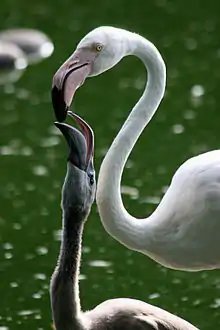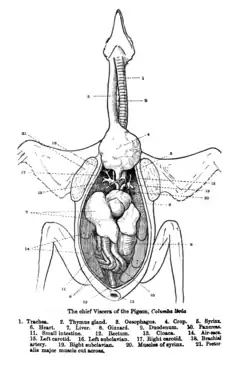Crop (anatomy)
A crop (sometimes also called a croup or a craw, ingluvies, or sublingual pouch) is a thin-walled expanded portion of the alimentary tract used for the storage of food prior to digestion. This anatomical structure is found in a wide variety of animals. It has been found in birds, and in invertebrate animals including gastropods (snails and slugs), earthworms,[1] leeches,[2] and insects.[3]



Insects
Cropping is used by bees to temporarily store nectar of flowers. When bees "suck" nectar, it is stored in their crops.[4] Other Hymenoptera also use crops to store liquid food. The crop in eusocial insects, such as ants, has specialized to be distensible, and this specialization enables important communication between colonial insects through trophallaxis. [5] The crop can be found in the foregut of insects. [6]
Birds
In a bird's digestive system, the crop is an expanded, muscular pouch near the gullet or throat. It is a part of the digestive tract, essentially an enlarged part of the esophagus. As with most other organisms that have a crop, it is used to temporarily store food. Not all bird species have one. In adult doves and pigeons, it can produce crop milk to feed newly hatched birds.[7]
Scavenging birds, such as vultures, will gorge themselves when prey is abundant, causing their crop to bulge. They subsequently sit, sleepy or half torpid, to digest their food.
Most raptors, including hawks, eagles and vultures (as stated above), have a crop; however, owls do not. Similarly, all true quail (Old World quail and New World quail) have a crop, but buttonquail do not. While chickens and turkeys possess a crop, geese do not have one.
Literary reference
In the Sherlock Holmes story "The Adventure of the Blue Carbuncle" (1892), author Arthur Conan Doyle hid a valuable gem inside a goose's crop. Unfamiliar with anserine anatomy, Doyle was not aware that geese do not have crops.[8]
See also
- Esophagus
- Gizzard
- Gular pouch, in bird anatomy, a flap generally used to store fish and other prey while hunting
- Intestines
- Proventriculus
- Stomach
References
- "Worm World: About Earthworms". Archived from the original on 2008-12-04. Retrieved 2008-12-16.
- Sawyer, Roy T. "Leech Biology and Behaviour, Volume II" (PDF). Retrieved 2014-01-09. Cite journal requires
|journal=(help) - Triplehorn, Charles A; Johnson, Norman F (2005). Borror and DeLong's introduction to the study of insects (7th ed.). Australia: Thomson, Brooks/Cole. ISBN 9780030968358.
- "Honeybee Biology". 1994. Retrieved 2008-12-16.
- "Oral transfer of chemical cues, growth proteins and hormones in social insects". 2019.
- Sal, Lorrianne K. "Digestion: An imperative process for insects".
- Gordon John Larkman Ramel (2008-09-29). "The Alimentary Canal in Birds". Retrieved 2008-12-16.
- Alfred Hickling. "Review: The New Annotated Sherlock Holmes edited by Leslie S Klinger | Books". The Guardian. Retrieved 2012-07-26.